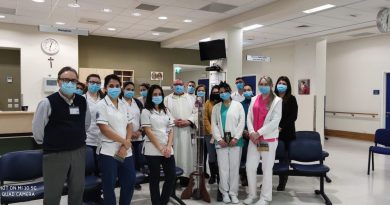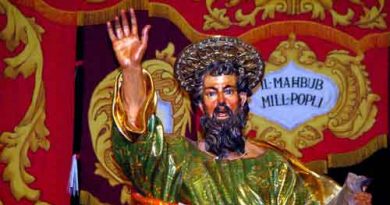The power of a hug
Ann Hood wrote: I have learned that there is more power in a good strong hug than in a thousand meaningful words.
Science got this one right too. In fact, a good hug is the easiest way to get oxytocin, also known as love drug. Hence, a hug calms the nervous system down and empowers positivity in you. Let us not forget that it reduces the production of cortisol, the stress hormone, thereby enabling you to stay more focused and also have good quality sleep. A hug helps releases other feel-good hormones such as serotorin. Hence, this makes you feel more empowered and ready to face obstacles with much strength.
If human hug is so powerful imagine how powerful it is when God hugs us. Let us appreciate what St Faustina had to say on this in her Diary in entry 432. At that very moment, I felt some kind of fire in my heart. I feel my senses deadening and have no idea of what is going on around me. I feel the Lord’s gaze piercing me through and through. I am very much aware of His greatness and my misery. An extraordinary suffering pervades my soul, together with a joy I cannot compare to anything. I feel powerless in the embrace of God. I feel that I am in Him and that I am dissolved in Him like a drop of water in the ocean. I cannot express what takes place within me; after such interior prayer, I feel strength and power to practice the most difficult virtues. I feel dislike for all things that the world holds in esteem. With all my soul I desire silence and solitude (Diary, 432).
In Jesus Christ God has become a human being like you and me. Therefore he incarnated the invisible God’s hug to us. He hugged us in order that we hug others and give them his healing through our hug. Pope Francis beautifully speaks about this when he addressed the meeting with the Italian Catholic Action “With Open Arms” at St Peter’s Square on Thursday 25 April 2024. He said:
Firstly, the embrace that is missing. The zeal you express so festively today is not always well-received in our world: at times it encounters narrow-mindedness, at times it encounters resistance, so the arms stiffen and the hands clench threateningly, becoming not vehicles of fraternity, but of rejection, of opposition, even violent at times, a sign of diffidence towards others, near and far, to the point of conflict. When the embrace transforms into a fist it is very dangerous. At the origin of wars there are often missing embraces or refused embraces, followed by prejudices, misunderstandings, suspicions, to the point of seeing the other as an enemy. And all this, unfortunately, in these days, is before our eyes in too many parts of the world! With your presence and your work, you can instead bear witness to everyone that the way of the embrace is the way of life.
Which leads us to the second passage... Now we see the embrace that saves. Already, in human terms, embracing means expressing positive and fundamental values such as affection, respect, trust, encouragement, reconciliation. But it becomes even more vital when it is lived in the dimension of faith. Indeed, at the centre of our existence is the merciful embrace of God who saves, the embrace of the good Father revealed in Christ, and whose face is reflected in every one of His gestures – forgiveness, healing, liberation, service (cf. Jn 13:1-15), and whose revelation reaches its culmination in the Eucharist and on the Cross, when Christ offers His life for the salvation of the world, for the good of whoever welcomes Him with a sincere heart, forgiving even His crucifiers (cf. Lk 23:24). And all this is shown to us so that we too can learn to do likewise. Therefore, never lose sight of the embrace of the Father who saves, the paradigm of life and heart of the Gospel, model of radicality in love, nurtured and inspired by the free and always superabundant gift of God (cf. Mt 5:44-48). Brothers and sisters, may we let ourselves be embraced by Him, like children (cf. Mt 18:2-3; Mk 10:13-16), may we let ourselves be embraced by Him like children. Each one of us has in their heart something of the child who needs a hug. May we let ourselves be embraced by the Lord. In this way, in the Lord’s embrace we leave how to embrace others.
Let us go to the third step: first, the missing embrace; second, the embrace that saves; and third, the embrace that changes life. An embrace can change life, show new paths, paths of hope. There are many saints in whose existence an embrace marked a decisive turning point, like Saint Francis, who left everything to follow the Lord after embracing a leper, as he himself recalls in his Testament (cf. FF 110: 1407-1408). And if this was valid for them, it applies to us too. For example, for your associative life, which is multiform and finds its common denominator precisely in the embrace of charity (cf. Col 3:14; Rom 13:10), the one essential mark of Christ’s disciples (cf. Lumen gentium, 42), the rule, form and end of every means of sanctification and apostolate. Let it shape your every effort and service, so that you may live faithful to your vocation and your history (cf. Address to Catholic Action, 30 April 2017).
Let us be present to someone by offering him and her a hug with a little squeeze to show the person that we care for him and her and that we mean it. A hug from 5 to 20 seconds can mean the whole world for that person.
Lord make me a channel of your hug to your children who are my brothers and sisters. Amen.
Fr Mario Attard OFM Cap





